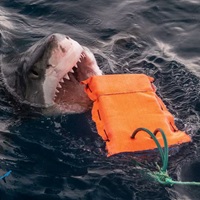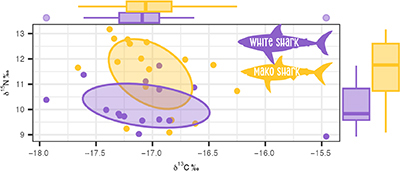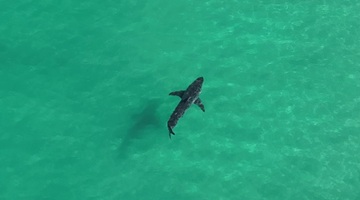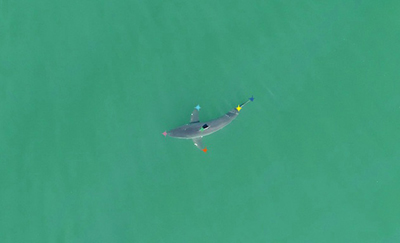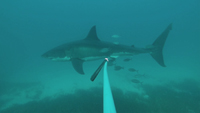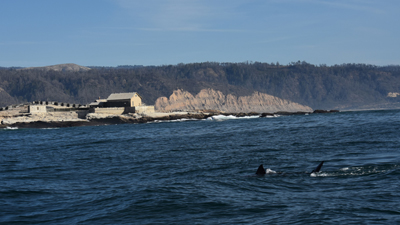White Sharks Global proceedings and recent advances in white shark ecology and conservation
Lightweight bite-resistant materials offer potential to reduce injuries and blood loss from shark bites, while maintaining flexibility for the user. This study aimed to assess effectiveness of four different bite-resistant fabrics at reducing damage resulting from bites from white and tiger sharks, two species responsible for the most fatalities in Australia. We highlight the ability of bite-resistant material to potentially reduce injuries, haemorrhaging and tissue loss from shark bites. There were no significant differences in substantial and critical damage between bite-resistant materials. Photograph supplied by Flinders University.
This article belongs to the collection: White Sharks Global proceedings and recent advances in white shark ecology and conservation.
White sharks and shortfin makos have faced critical population declines in the Mediterranean Sea. This study analyzed the trophic ecology of individuals captured on the Tunisian Plateau, showing their prey preferences and highlighting patterns of niche partitioning among juvenile stages. Our findings emphasize the need for targeted conservation strategies to ensure the survival of these apex predators. Diagram by Chiara Gambardella.
This article belongs to the collection: White Sharks Global proceedings and recent advances in white shark ecology and conservation.
Juvenile white sharks in southern California most use neritic habitat from the shoreline to >5 km from shore and water depths to 100 m. Using stable isotope analysis and acoustic tracking, we found that sharks sampled nearshore and offshore exhibit isotopic signatures reflecting the respective habitats where they were encountered. This study showed that juvenile white sharks may rely on resources beyond California State waters as they mature, affecting management strategies. Photograph by Patrick Rex.
This article belongs to the collection: White Sharks Global proceedings and recent advances in white shark ecology and conservation.
Advances in drone technology and computer vision are transforming the study of coastal ecosystems and resident megafauna. This study employs aerial focal follows of white sharks to develop and test a body pose estimation model that quantifies swimming kinematics with high performance. This scalable, non-invasive approach offers wildlife managers and researchers an effective tool for monitoring marine megafauna without the challenges of traditional invasive approaches. Photograph by Alexandra DiGiacomo.
This article belongs to the collection: White Sharks Global proceedings and recent advances in white shark ecology and conservation.
The effect of wildlife tourism on non-target species is understudied. We assessed the impacts of bait and berley input on fish assemblages at a white shark cage-diving site by using underwater cameras. Abundances of some species were higher at the tourist site, but species diversity and evenness were comparable to offshore islands without cage-diving. Overall, current management regulations for the cage-diving industry are effective in minimising impacts to non-target species. Photograph by the Southern Shark Ecology Group.
This article belongs to the collection: White Sharks Global proceedings and recent advances in white shark ecology and conservation.
We report the discovery of potential population connectivity between southern Africa and Southeast Asia. This short communication details the chain of events that led to the recovery of a long defunct satellite transmitter, made possible through the trusting relationships and respect built between shark fishers and conservation organisations in the region. Further areas of research focus and collaboration are highlighted. Photograph by Caragh Fraser.
This article belongs to the collection: White Sharks Global proceedings and recent advances in white shark ecology and conservation.
We used acoustic tracking to examine seasonal habitat use of subadult and adult white sharks in central California, focusing on aggregation patterns near pinniped colonies. Data from 355 tags, deployed between 2006 and 2022, showed that adult males displayed the highest residency and earlier seasonal peaks, whereas subadults demonstrated higher coastal affinity year-round. The differences in habitat use among demographic groups are likely to be due to varying foraging and reproductive strategies, with expanded tracking showing new potential aggregation sites. Photograph by Samantha Andrzejaczek.
This article belongs to the collection: White Sharks Global proceedings and recent advances in white shark ecology and conservation.
Understanding the population structure and connectivity of highly migratory fishes across their range is crucial information to develop and implement conservation initiatives for vulnerable species. This study aimed to characterise the extent of ontogenetic divergence in resource–habitat behaviour of two proposed subpopulations of white sharks in Australia. Differences in isotopic profiles of vertebrae across ontogeny from juvenile to subadult life stages support an ecological two-population model in Australia, suggesting the need for region-specific management. Photograph by Teah Burke.
This article belongs to the collection: White Sharks Global proceedings and recent advances in white shark ecology and conservation.



